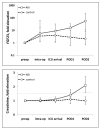Plasma FGF23 levels increase rapidly after acute kidney injury
- PMID: 23657144
- PMCID: PMC3766419
- DOI: 10.1038/ki.2013.150
Plasma FGF23 levels increase rapidly after acute kidney injury
Abstract
Emerging evidence suggests that fibroblast growth factor 23 (FGF23) levels are elevated in patients with acute kidney injury (AKI). In order to determine how early this increase occurs, we used a murine folic acid-induced nephropathy model and found that plasma FGF23 levels increased significantly from baseline already after 1 h of AKI, with an 18-fold increase at 24 h. Similar elevations of FGF23 levels were found when AKI was induced in mice with osteocyte-specific parathyroid hormone receptor ablation or the global deletion of parathyroid hormone or the vitamin D receptor, indicating that the increase in FGF23 was independent of parathyroid hormone and vitamin D signaling. Furthermore, FGF23 levels increased to a similar extent in wild-type mice maintained on normal or phosphate-depleted diets prior to induction of AKI, indicating that the marked FGF23 elevation is at least partially independent of dietary phosphate. Bone production of FGF23 was significantly increased in AKI. The half-life of intravenously administered recombinant FGF23 was only modestly increased. Consistent with the mouse data, plasma FGF23 levels rose 15.9-fold by 24 h following cardiac surgery in patients who developed AKI. The levels were significantly higher than in those without postoperative AKI. Thus, circulating FGF23 levels rise rapidly during AKI in rodents and humans. In mice, this increase is independent of established modulators of FGF23 secretion.
Figures







Comment in
-
Dietary phosphate: the challenges of exploring its role in FGF23 regulation.Kidney Int. 2013 Oct;84(4):639-41. doi: 10.1038/ki.2013.198. Kidney Int. 2013. PMID: 24080872
References
-
- Burnett SM, Gunawardene SC, Bringhurst FR, Jüppner H, Lee H, Finkelstein JS. Regulation of C-terminal and intact FGF-23 by dietary phosphate in men and women. J Bone Miner Res. 2006 Aug;21(8):1187–1196. - PubMed
-
- Antoniucci DM, Yamashita T, Portale AA. Dietary phosphorus regulates serum fibroblast growth factor-23 concentrations in healthy men. J Clin Endocrinol Metab. 2006 Aug;91(8):3144–3149. - PubMed
-
- Lavi-Moshayoff V, Wasserman G, Meir T, Silver J, Naveh-Many T. PTH increases FGF23 gene expression and mediates the high-FGF23 levels of experimental kidney failure: a bone parathyroid feedback loop. Am J Physiol Renal Physiol. 2010 Oct;299(4):F882–889. - PubMed
-
- Wesseling-Perry K, Pereira RC, Sahney S, Gales B, Wang HJ, Elashoff R, Jüppner H, Salusky IB. Calcitriol and doxercalciferol are equivalent in controlling bone turnover, suppressing parathyroid hormone, and increasing fibroblast growth factor-23 in secondary hyperparathyroidism. Kidney Int. 2011 Jan;79(1):112–119. - PubMed
Publication types
MeSH terms
Substances
Grants and funding
- U01DK085660/DK/NIDDK NIH HHS/United States
- P01 DK11794/DK/NIDDK NIH HHS/United States
- R01 DK093574/DK/NIDDK NIH HHS/United States
- R01 DK076116/DK/NIDDK NIH HHS/United States
- R01 DK081374/DK/NIDDK NIH HHS/United States
- K08 DK93608/DK/NIDDK NIH HHS/United States
- T32 DK007527/DK/NIDDK NIH HHS/United States
- K08 DK090143/DK/NIDDK NIH HHS/United States
- R01DK093574/DK/NIDDK NIH HHS/United States
- R01 AR060221/AR/NIAMS NIH HHS/United States
- K08 DK093608/DK/NIDDK NIH HHS/United States
- P01 DK011794/DK/NIDDK NIH HHS/United States
LinkOut - more resources
Full Text Sources
Other Literature Sources
Medical

